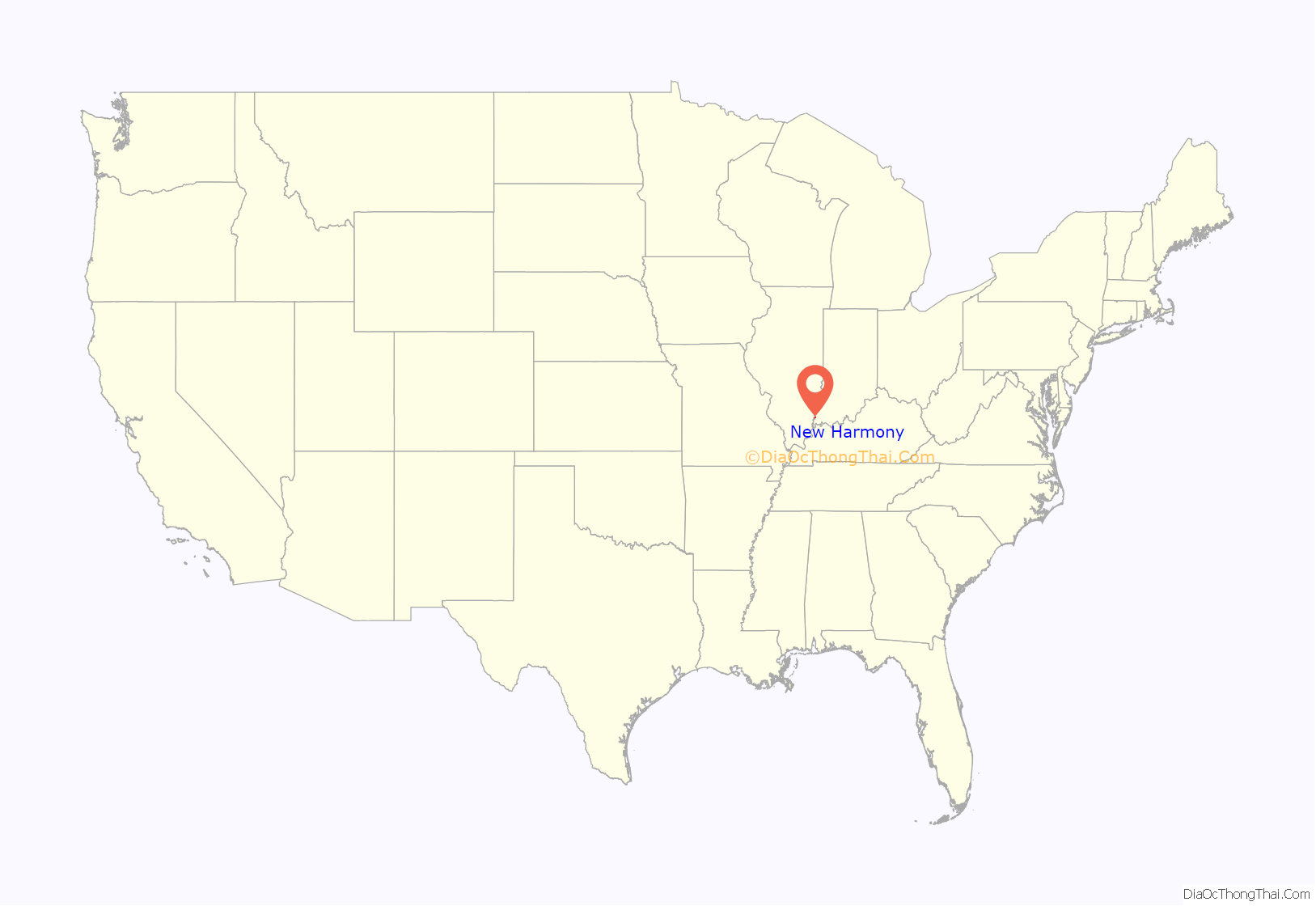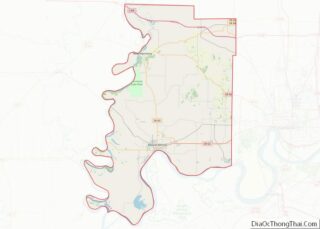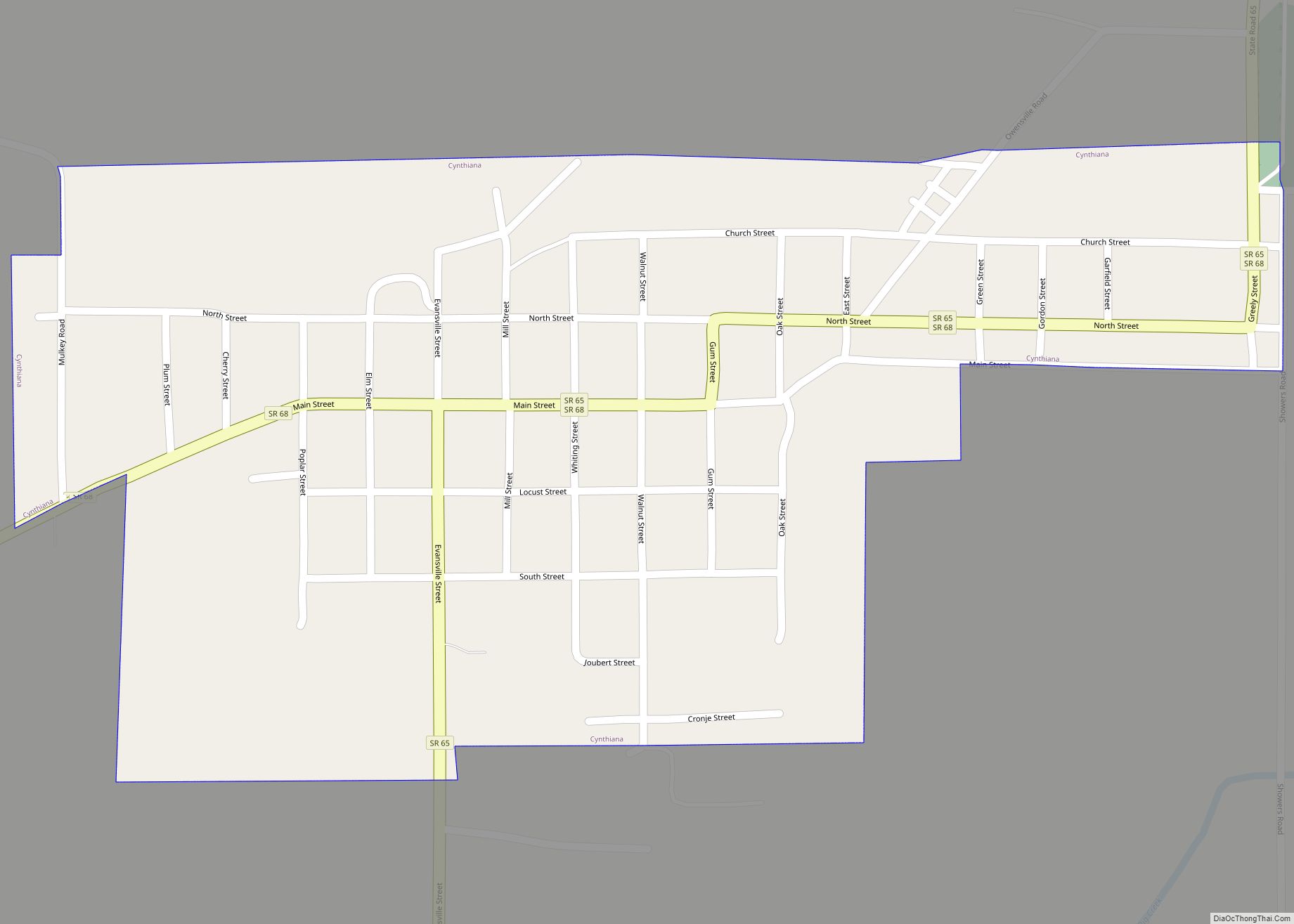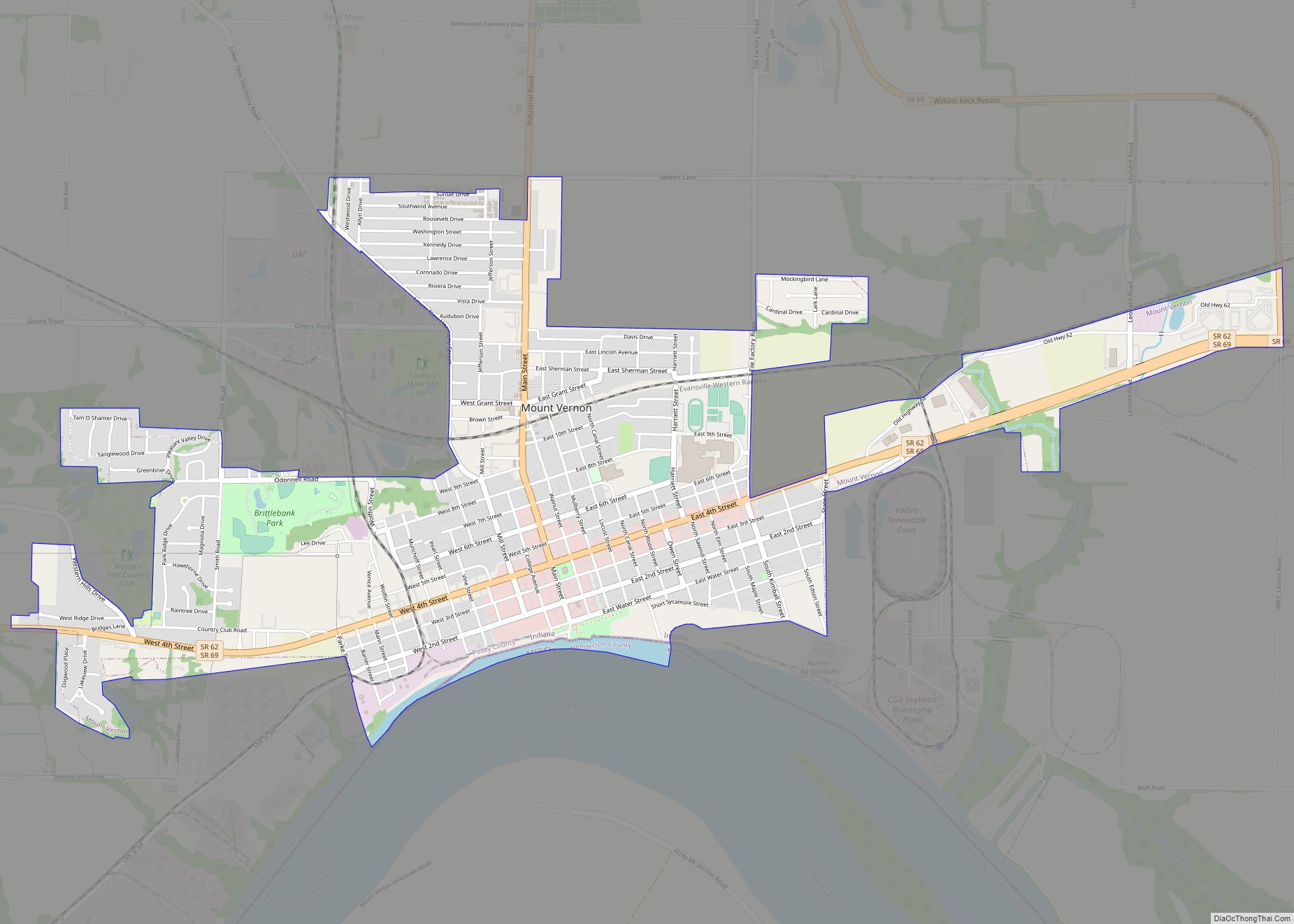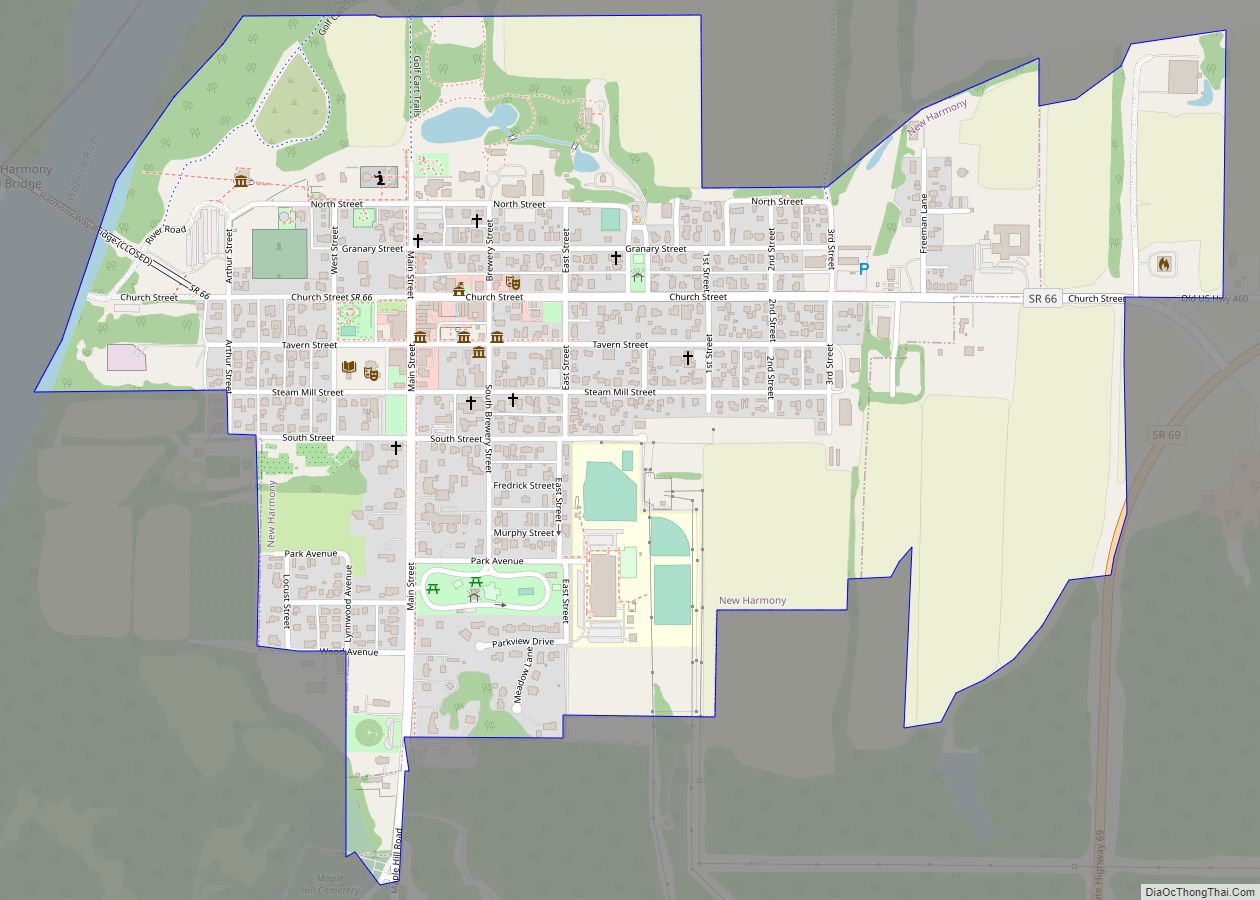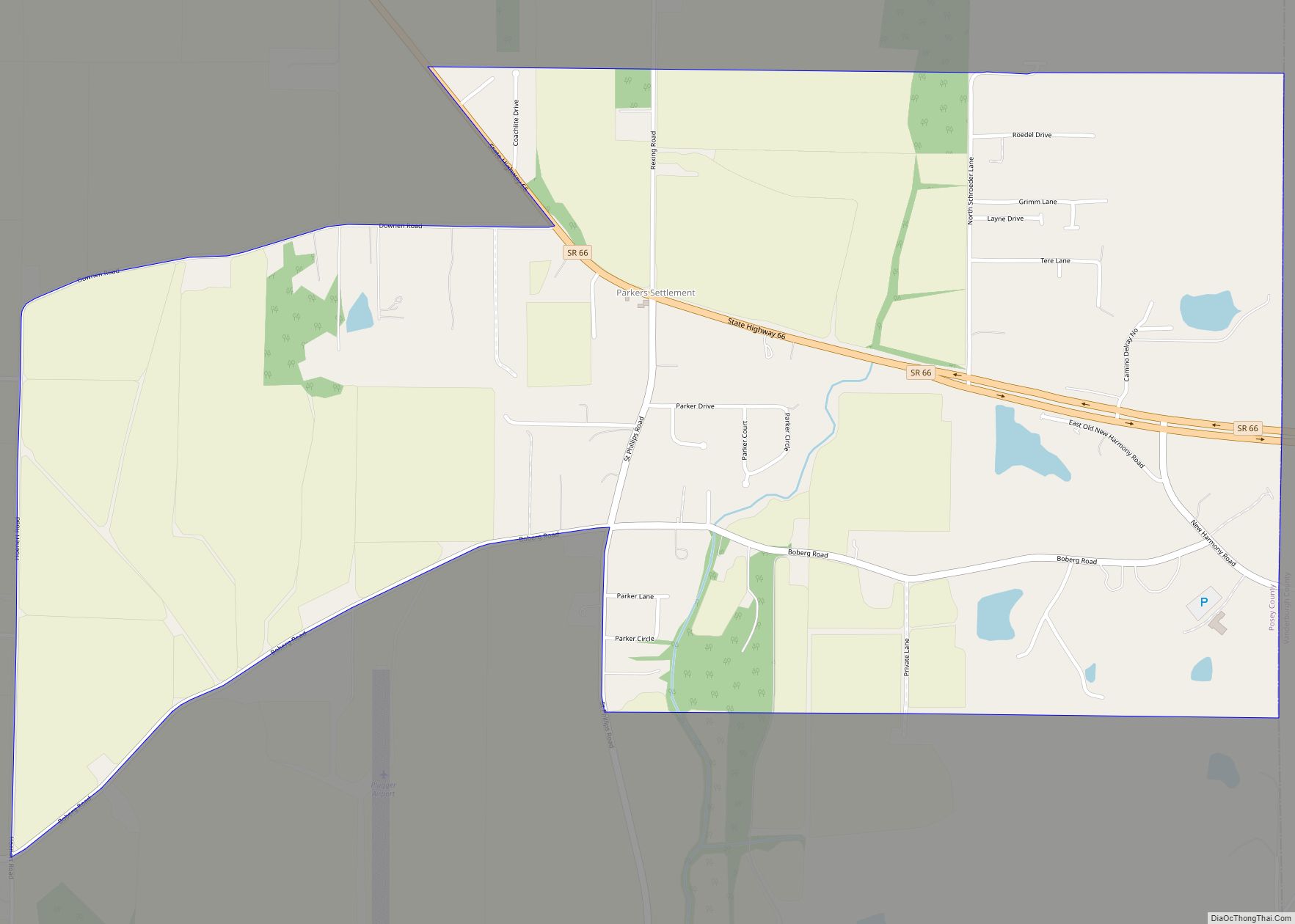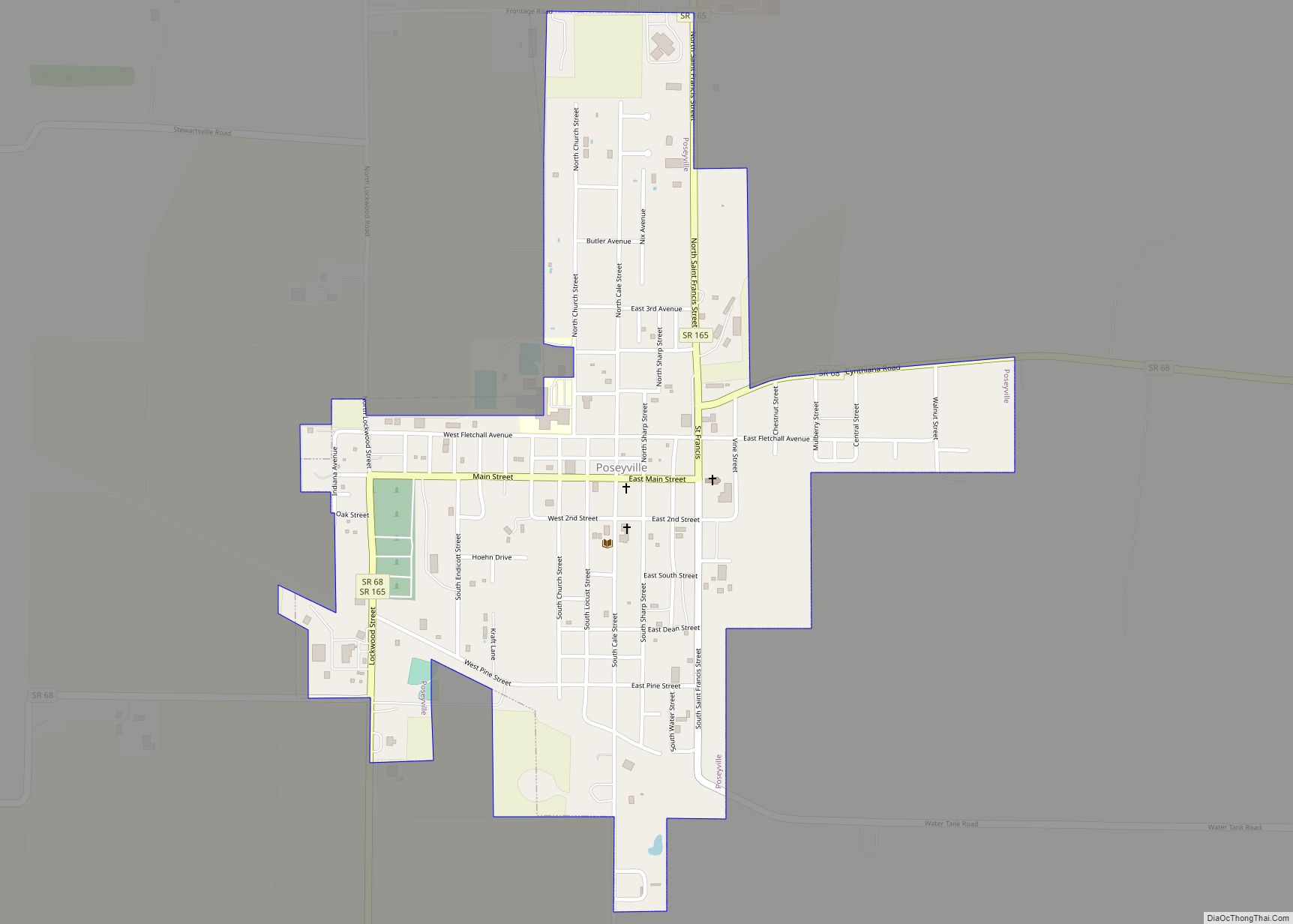New Harmony is a historic town on the Wabash River in Harmony Township, Posey County, Indiana. It lies 15 miles (24 km) north of Mount Vernon, the county seat, and is part of the Evansville metropolitan area. The town’s population was 789 at the 2010 census.
Established by the Harmony Society in 1814 under the leadership of George Rapp, the town was originally known as Harmony (also called Harmonie, or New Harmony). In its early years the 20,000-acre (8,100 ha) settlement was the home of Lutherans who had separated from the official church in the Duchy of Württemberg and immigrated to the United States. The Harmonists built a new town in the wilderness, but in 1824 they decided to sell their property and return to Pennsylvania. Robert Owen, a Welsh industrialist and social reformer, purchased the town in 1825 with the intention of creating a new utopian community and renamed it New Harmony. The Owenite social experiment failed two years after it began.
New Harmony changed American education and scientific research. Town residents established the first public library, a civic drama club, and a public school system open to men and women. Its prominent citizens included Owen’s sons: Robert Dale Owen, an Indiana congressman and social reformer who sponsored legislation to create the Smithsonian Institution; David Dale Owen, a noted state and federal geologist; William Owen, a New Harmony businessman; and Richard Owen, Indiana state geologist, Indiana University professor, and first president of Purdue University. The town also served as the second headquarters of the U.S. Geological Survey. Numerous scientists and educators contributed to New Harmony’s intellectual community, including William Maclure, Marie Louise Duclos Fretageot, Thomas Say, Charles-Alexandre Lesueur, Joseph Neef, Frances Wright, and others.
Many of the town’s old Harmonist buildings have been restored. These structures, along with others related to the Owenite community, are included in the New Harmony Historic District. Contemporary additions to the town include the Roofless Church and Atheneum. The New Harmony State Memorial is located south of town on State Road 69 in Harmonie State Park.
| Name: | New Harmony town |
|---|---|
| LSAD Code: | 43 |
| LSAD Description: | town (suffix) |
| State: | Indiana |
| County: | Posey County |
| Elevation: | 377 ft (115 m) |
| Total Area: | 0.82 sq mi (2.13 km²) |
| Land Area: | 0.81 sq mi (2.11 km²) |
| Water Area: | 0.01 sq mi (0.02 km²) |
| Total Population: | 789 |
| Population Density: | 923.93/sq mi (356.82/km²) |
| ZIP code: | 47631 |
| Area code: | 812 |
| FIPS code: | 1852974 |
| GNISfeature ID: | 2396802 |
| Website: | http://www.newharmony-in.gov |
Online Interactive Map
Click on ![]() to view map in "full screen" mode.
to view map in "full screen" mode.
New Harmony location map. Where is New Harmony town?
History
Harmonist settlement (1814–1824)
The town of Harmony was founded by the Harmony Society in 1814 under the leadership of German immigrant George Rapp (born Johann Georg Rapp). It was the second of three towns built by the pietist, communal religious group, known as Harmonists, Harmonites, or Rappites. The Harmonists settled in the Indiana Territory after leaving Harmony, Pennsylvania, where westward expansion, the area’s rising population, jealous neighbors, and the increasing cost of land threatened the Society’s desire for isolation.
In April 1814 Anna Mayrisch, John L. Baker, and Ludwick Shirver (Ludwig Schreiber) traveled west in search of a new location for their congregation, one that would have fertile soil and access to a navigable waterway. By May 10 the men had found suitable land along the Wabash River in the Indiana Territory and made an initial purchase of approximately 7,000 acres (28 km). Rapp wrote on May 10, “The place is 25 miles from the Ohio mouth of the Wabash, and 12 miles from where the Ohio makes its curve first before the mouth. The town will be located about 1/4 mile from the river above on the channel on a plane as level as the floor of a room, perhaps a good quarter mile from the hill which lies suitable for a vineyard.” Although Rapp expressed concern that the town’s location lacked a waterworks, the area provided an opportunity for expansion and access to markets through the nearby rivers, causing him to remark, “In short, the place has all the advantages which one could wish, if a steam engine meanwhile supplies what is lacking.”
The first Harmonists left Pennsylvania in June 1814 and traveled by flatboat to their new land in the Indiana Territory. In May 1815 the last of the Harmonists who had remained behind until the sale of their town in Pennsylvania was completed departed for their new town along the Wabash River. Frederick Reichert Rapp, George Rapp’s adopted son, drew up the town plan for their new village at Harmony, Indiana, which surveyors laid out on August 8, 1814. By 1816, the same year that Indiana became a state, the Harmonists had acquired 20,000 acres (81 km) of land, built 160 homes and other buildings, and cleared 2,000 acres (8.1 km) for their new town. The settlement also began to attract new arrivals, including emigrants from Germany such as members of Rapp’s congregation from Württemberg, many of whom expected the Harmonists to pay for their passage to America. However, the new arrivals “were more of a liability than an asset”. On March 20, 1819, Rapp commented, “It is astonishing how much trouble the people who have arrived here have made, for they have no morals and do not know what it means to live a moral and well-mannered life, not to speak of true Christianity, of denying the world or yourself.”
Visitors to Harmony commented on the commercial and industrial work being done in this religious settlement along the Wabash River. “It seemed as though I found myself in the midst of Germany,” noted one visitor. In 1819 the town had a steam-operated wool carding and spinning factory, a horse-drawn and human-powered threshing machine, a brewery, distillery, vineyards, and a winery. The property included an orderly town, “laid out in a square”, with a church, school, store, dwellings for residents, and streets to create “the most beautiful city of western America, because everything is built in the most perfect symmetry”. Other visitors were not as impressed: “hard labor & coarse fare appears to be the lot of all except the family of Rapp, he lives in a large & handsome brick house while the rest inhabit small log cabins. How so numerous a population are kept quietly & tamely in absolute servitude it is hard to conceive—the women I believe do more labor in the field than the men, as large numbers of the latter are engaged in different branches of manufactures.” Although they were not paid for their work, the 1820 manufacturer’s census reported that 75 men, 12 women, and 30 children were employed, in the Society’s tanneries, saw and grain mills, and woolen and cotton mills. Manufactured goods included cotton, flannel, and wool cloth, yarn, knit goods, tin ware, rope, beer, peach brandy, whiskey, wine, wagons, carts, plows, flour, beef, pork, butter, leather, and leather goods.
The Harmonist community continued to thrive during the 1820s, but correspondence from March 6, 1824, between Rapp and his adopted son, Frederick, indicates that the Harmonists planned to sell their Indiana property and were already looking for a new location. In May, a decade after their arrival in Indiana, the Harmonists purchased land along the Ohio River eighteen miles from Pittsburgh, Pennsylvania, and were making arrangements to advertise the sale of their property in Indiana. The move, although it was made primarily for religious reasons, would provide the Harmonists with easier access to eastern markets and a place where they could live more peacefully with others who shared their German language and culture. On May 24, 1824, a group of Harmonists boarded a steamboat and departed Indiana, bound for Pennsylvania, where they founded the community of Economy, the present-day town of Ambridge. In May 1825 the last Harmonists left Indiana after the sale of their 20,000 acres (81 km) of property, which included the land and buildings, to Robert Owen for $150,000. Owen hoped to establish a new community on the Indiana frontier, one that would serve as a model community for communal living and social reform.
West Street Log Cabins
Eigner Cabin
Potter Cabin
Owenite community (1825–1827)
Robert Owen was a social reformer and wealthy industrialist who made his fortune from textile mills in New Lanark, Scotland. Owen, his twenty-two-year-old son, William, and his Scottish friend Donald McDonald sailed to the United States in 1824 to purchase a site to implement Owen’s vision for “a New Moral World” of happiness, enlightenment, and prosperity through education, science, technology, and communal living. Owen believed his utopian community would create a “superior social, intellectual and physical environment” based on his ideals of social reform. Owen was motivated to buy the town in order to prove his theories were viable and to correct the troubles that were affecting his mill-town community New Lanark. The ready-built town of Harmony, Indiana, fitted Owen’s needs. In January 1825 he signed the agreement to purchase the town, renamed it New Harmony, and invited “any and all” to join him there. While many of the town’s new arrivals had a sincere interest in making it a success, the experiment also attracted “crackpots, free-loaders, and adventurers whose presence in the town made success unlikely.” William Owen, who remained in New Harmony while his father returned east to recruit new residents, also expressed concern in his diary entry, dated March 24, 1825: “I doubt whether those who have been comfortable and content in their old mode of life, will find an increase of enjoyment when they come here. How long it will require to accustom themselves to their new mode of living, I am unable to determine.”
When Robert Owen returned to New Harmony in April 1825 he found seven hundred to eight hundred residents and a “chaotic” situation, much in need of leadership. By May 1825 the community had adopted the “Constitution of the Preliminary Society,” which loosely outlined its expectations and government. Under the preliminary constitution, members would provide their own household goods and invest their capital at interest in an enterprise that would promote independence and social equality. Members would render services to the community in exchange for credit at the town’s store, but those who did not want to work could purchase credit at the store with cash payments made in advance. In addition, the town would be governed by a committee of four members chosen by Owen and the community would elect three additional members. In June, Robert Owen left William in New Harmony while he traveled east to continue promoting his model community and returned to Scotland, where he sold his interests in the New Lanark textile mills and arranged financial support for his wife and two daughters, who chose to remain in Scotland. Owen’s four sons, Robert Dale, William, David Dale, and Richard, and a daughter, Jane Dale, later settled in New Harmony.
While Owen was away recruiting new residents for New Harmony, a number of factors that led to an early breakup of the socialist community had already begun. Members grumbled about inequity in credits between workers and non-workers. In addition, the town soon became overcrowded, lacked sufficient housing, and was unable to produce enough to become self-sufficient, although they still had “high hopes for the future.” Owen spent only a few months at New Harmony, where a shortage of skilled craftsmen and laborers along with inadequate and inexperienced supervision and management contributed to its eventual failure.
Despite the community’s shortcomings, Owen was a passionate promoter of his vision for New Harmony. While visiting Philadelphia, Owen met Marie Louise Duclos Fretageot, a Pestalozzian educator, and persuaded her to join him in Indiana. Fretageot encouraged William Maclure, a scientist and fellow educator, to become a part of the venture. (Maclure became Owen’s financial partner.) On January 26, 1826, Fretegeot, Maclure, and a number of their colleagues, including Thomas Say, Josef Neef, Charles-Alexandre Lesueur, and others aboard the keelboat Philanthropist (also called the “Boatload of Knowledge”), arrived in New Harmony to help Owen establish his new experiment in socialism.
On February 5, 1826, the town adopted a new constitution, “The New Harmony Community of Equality”, whose objective was to achieve happiness based on principles of equal rights and equality of duties. Cooperation, common property, economic benefit, freedom of speech and action, kindness and courtesy, order, preservation of health, acquisition of knowledge, and obedience to the country’s laws were included as part of the constitution. The constitution laid out the life of a citizen in New Harmony based on age. Children from the age of one to five were to be cared for and encouraged to exercise; children aged six to nine they were to be lightly employed and given education via observation directed by skilled teachers. Youth from the ages of ten to twelve were to help in the houses and with the gardening. Teenagers from the age of twelve to fifteen were to receive technical training, and from fifteen to twenty their education was to be continued. Young adults from the ages of twenty to thirty were to act as a superintendent in the production and education departments. Adults from the ages of thirty to forty were to govern the homes, and residents aged forty to sixty were to be encouraged to assist with the community’s external relations or to travel abroad if they so desired.
Although the constitution contained worthy ideals, it did not clearly address how the community would function and was never fully established. Individualist anarchist Josiah Warren, who was one of the original participants in the New Harmony Society, asserted that the community was doomed to failure due to a lack of individual sovereignty and private property. He commented: “It seemed that the difference of opinion, tastes and purposes increased just in proportion to the demand for conformity. Two years were worn out in this way; at the end of which, I believe that not more than three persons had the least hope of success. Most of the experimenters left in despair of all reforms, and conservatism felt itself confirmed. We had tried every conceivable form of organization and government. We had a world in miniature. –we had enacted the French revolution over again with despairing hearts instead of corpses as a result. …It appeared that it was nature’s own inherent law of diversity that had conquered us …our ‘united interests’ were directly at war with the individualities of persons and circumstances and the instinct of self-preservation… and it was evident that just in proportion to the contact of persons or interests, so are concessions and compromises indispensable.” (Periodical Letter II 1856).
Part of New Harmony’s failings stemmed from three activities that Owen brought from Scotland to America. First, Owen actively attacked established religion, despite United States’ constitutional guarantees of religious freedom and the separations of church and state. Second, Owen remained stubbornly attached to the principles of the rationalist Age of Enlightenment, which drove away many of the Jeffersonian farmers Owen tried to attract. Thirdly, Owen consistently appealed to the upper class for donations, but found that the strategy was not as effective as it had been in Europe.
Robert Dale Owen wrote that the members of the failed socialist experiment at New Harmony were “a heterogeneous collection of radicals, enthusiastic devotees to principle, honest latitudinarians, and lazy theorists, with a sprinkling of unprincipled sharpers thrown in,” and that “a plan which remunerates all alike, will, in the present condition of society, ultimately eliminate from a co-operative association the skilled, efficient and industrious members, leaving an ineffective and sluggish residue, in whose hands the experiment will fail, both socially and pecuniarily.” However, he still thought that “co-operation is a chief agency destined to quiet the clamorous conflicts between capital and labour; but then it must be co-operation gradually introduced, prudently managed, as now in England.” In 1826 splinter groups dissatisfied with the efforts of the larger community broke away from the main group and prompted a reorganization.
In New Harmony work was divided into six departments, each with its own superintendent. These departments included agriculture, manufacturing, domestic economy, general economy, commerce, and literature, science and education. A governing council included the six superintendents and an elected secretary. Despite the new organization and constitution, members continued to leave town. By March 1827, after several other attempts to reorganize, the utopian experiment had failed.
The larger community, which lasted until 1827, was divided into smaller communities that led further disputes. Individualism replaced socialism in 1828 and New Harmony was dissolved in 1829 due to constant quarrels. The town’s parcels of land and property were returned to private use. Owen spent $200,000 of his own funds to purchase New Harmony property and pay off the community’s debts. His sons, Robert Dale and William, gave up their shares of the New Lanark mills in exchange for shares in New Harmony. Later, Owen “conveyed the entire New Harmony property to his sons in return for an annuity of $1,500 for the remainder of his life.” Owen left New Harmony in June 1827 and focused his interests in the United Kingdom. He died in 1858.
New Harmony Road Map
New Harmony city Satellite Map
Geography
The Wabash River forms the western boundary of New Harmony. It is the westernmost settlement in Indiana.
According to the 2010 census, New Harmony has a total area of 0.65 square miles (1.68 km), of which 0.64 square miles (1.66 km) (or 98.46%) is land and 0.01 square miles (0.03 km) (or 1.54%) is water.
Climate
The climate in this area is characterized by hot, humid summers and generally mild to cool winters. According to the Köppen Climate Classification system, New Harmony has a humid subtropical climate, abbreviated “Cfa” on climate maps.
See also
Map of Indiana State and its subdivision:- Adams
- Allen
- Bartholomew
- Benton
- Blackford
- Boone
- Brown
- Carroll
- Cass
- Clark
- Clay
- Clinton
- Crawford
- Daviess
- De Kalb
- Dearborn
- Decatur
- Delaware
- Dubois
- Elkhart
- Fayette
- Floyd
- Fountain
- Franklin
- Fulton
- Gibson
- Grant
- Greene
- Hamilton
- Hancock
- Harrison
- Hendricks
- Henry
- Howard
- Huntington
- Jackson
- Jasper
- Jay
- Jefferson
- Jennings
- Johnson
- Knox
- Kosciusko
- LaGrange
- Lake
- Lake Michigan
- LaPorte
- Lawrence
- Madison
- Marion
- Marshall
- Martin
- Miami
- Monroe
- Montgomery
- Morgan
- Newton
- Noble
- Ohio
- Orange
- Owen
- Parke
- Perry
- Pike
- Porter
- Posey
- Pulaski
- Putnam
- Randolph
- Ripley
- Rush
- Saint Joseph
- Scott
- Shelby
- Spencer
- Starke
- Steuben
- Sullivan
- Switzerland
- Tippecanoe
- Tipton
- Union
- Vanderburgh
- Vermillion
- Vigo
- Wabash
- Warren
- Warrick
- Washington
- Wayne
- Wells
- White
- Whitley
- Alabama
- Alaska
- Arizona
- Arkansas
- California
- Colorado
- Connecticut
- Delaware
- District of Columbia
- Florida
- Georgia
- Hawaii
- Idaho
- Illinois
- Indiana
- Iowa
- Kansas
- Kentucky
- Louisiana
- Maine
- Maryland
- Massachusetts
- Michigan
- Minnesota
- Mississippi
- Missouri
- Montana
- Nebraska
- Nevada
- New Hampshire
- New Jersey
- New Mexico
- New York
- North Carolina
- North Dakota
- Ohio
- Oklahoma
- Oregon
- Pennsylvania
- Rhode Island
- South Carolina
- South Dakota
- Tennessee
- Texas
- Utah
- Vermont
- Virginia
- Washington
- West Virginia
- Wisconsin
- Wyoming
